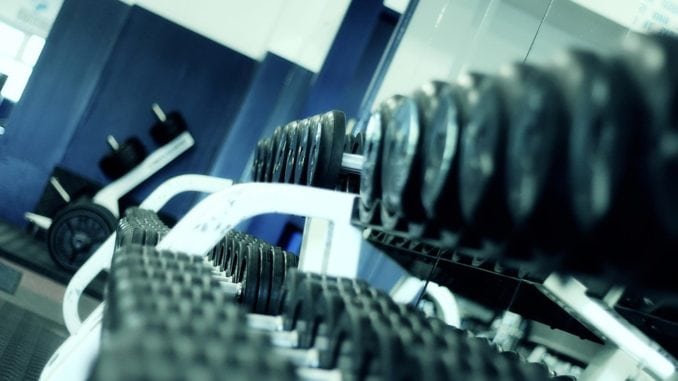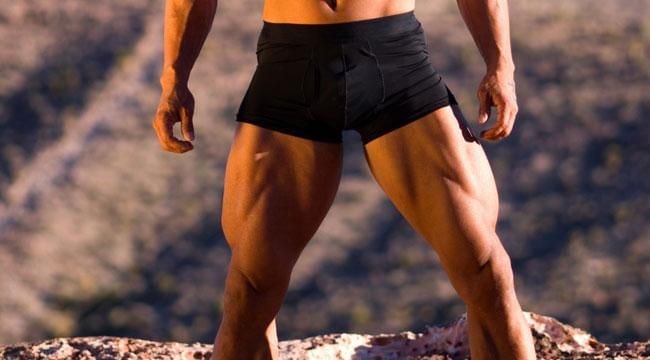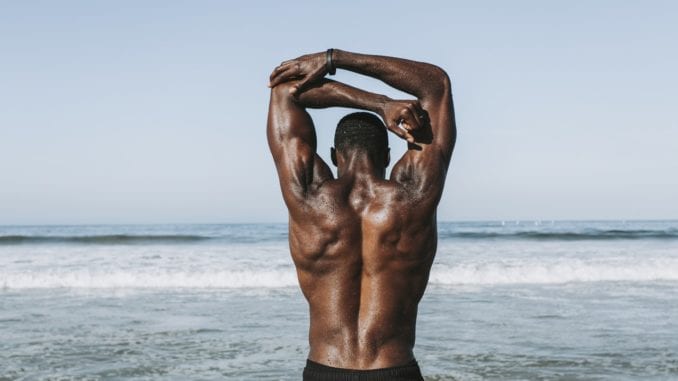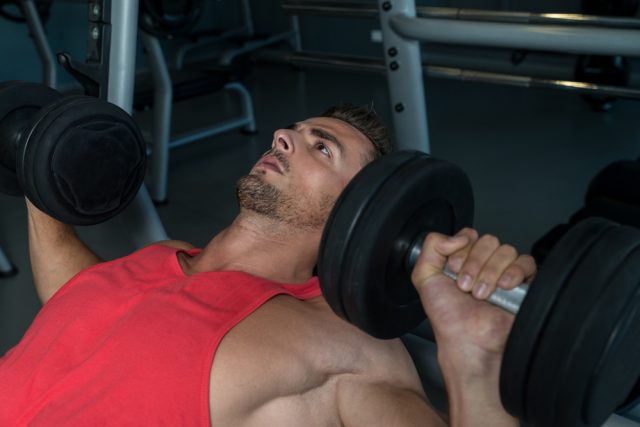Weight training and martial arts – a great match!
If you’re looking for a competitive edge in martial arts or you simply need to mix up your training regimen, then check out this weight training routine specifically designed for martial artists.
I’ve trained in several different styles of martial arts – capoeira, ninjutsu, chi gung and traditional Shaolin gung fu for many years. Most of these styles incorporate resistance training and strength building in their regular drills, but I’ve found that lifting weights can help gain more power and build muscular endurance.
More muscular power means that you will hit harder and have more effective strikes. Muscular endurance is your ability to repeat the same strikes repetitively without reaching fatigue.
Lifting weights for martial arts isn’t cheating; think of it as just sharpening your blade. Afterall, most people who engage in martial arts these days do it for the health benefits, not to be lethal fighters.
According to IBIS World statistics, 73% of people who practice martial arts or attend classes at a studio do so for physical fitness.
So, this article will show you some strength building routines that are especially useful to fitness-minded martial artists. Now, if you train in martial arts already, then you might not have a lot of extra training time to spare.
That’s why each routine in this guide has relatively simple exercises that are designed to give you the best results in the least amount of time. If you’re new to martial arts, then these exercises will help prepare your body for the many physical challenges that lie ahead.
Your Weightlifting Schedule
Time management is key when you train regularly in any martial arts form. Your sensei or instructor will undoubtably encourage you to keep a rigorous schedule of training days and rest days, so squeezing in some gym time is that much more difficult.
So, my weightlifting schedule is broken down into two separate sessions per week – one for the upper body and one for the lower body. If that doesn’t work for you, then by all means, stick to what you’re currently doing.
Just be sure to rest and recharge your body in-between sessions because over-training will always be counter-productive to your martial arts progress. 10-20% of athletes experience overtraining, resulting in weight loss, chronic decreases in testosterone, performance and impaired ability to train.
As a martial arts practitioner, it is so easy to slip into over-training. So, please be careful.
These exercises make use of traditional resistance equipment that you will find in any gym. There are no kettlebells, battle ropes, or oversized tires to flip in this routine. Sorry, not sorry.
I’m not knocking those methods. I know they’re popular, but my chi gung instructor once gave me a great piece of advice that I will share with you. He said, “you should train your body like a tractor, not like a race car.
You can put just about any type of fuel into a tractor and it will pull all day long.
One tractor does the same job as another. Kick it, beat it, bang it up and it still gets the job done. But a race car needs special fuel, special conditions, special equipment and special handling to work at its best, and aversity rarely finds you at your best.” Since hearing that advice, I’ve chosen to keep my weight-lifting schedule as simple as possible.
Now, let’s take a closer look at the exercise routines themselves.
 Day One – Upper Body
Day One – Upper Body
Equipment Needed: adjustable workout bench with a plate-loaded barbell and medium weight dumbbells
Major Muscles Worked: triceps, biceps, pectoralis, deltoids, trapezius, brachioradialis
Directions: For your upper body weightlifting day, start with the heaviest weight sets and work your way down. According to ACE Fitness, the plate-loaded barbell bench press is the most comprehensive and effective way to target the pectoralis muscles of your chest. Do three to four sets of 8 to 12 repetitions with at least three minutes of rest between sets.
Now, stand up, keep that heavy weight loaded onto the barbell and do three to four sets of shoulder shrugs. Try to do at least 8 to 12 repetitions. This will work the trapezius muscles and the levator scapulae of your neck. This exercise is especially helpful for martial artists because strengthening the muscles of your neck and upper back help to resist takedowns during grappling sessions.
Now, you’re going to move onto the dumbbells. Grab two medium weight dumbbells and perform three to four sets of overhead military presses. Go for 8 to 12 repetitions and be sure to rest between sets. Now, some people recommend doing these with a barbell or seated if using dumbbells.
However, if you perform this exercise in a standing position you will need to engage the core muscles for stability, which is most conducive to your martial arts training. Just make sure your form is clean, keep your knees slightly bent and your back straight.
Keep your elbows close to the body on the down stroke and press up until your elbows are fully extended. The main muscle target is the deltoid group in your shoulders, but you will feel your trapezius and pectoralis muscles firing, as well.
For the next segment, you’ll need to raise the bench to an inclined position. Place your dumbbells on your thighs at rest and then lift them up to the shoulders as you lay back on the bench. Press them over your head (the inclined dumbbell press) and back down to parallel with your shoulders for three sets of 8 to 12 repetitions.
We’re hitting the upper band of the pectoralis muscle in your chest this time to build your punching power. For more detailed instruction on the inclined dumbbell press, check out ExRx’s page and video.
Now, move on to the dumbbell preacher curl. This exercise is best done with a preacher curl bench but remember what my sensei said and use what you have at hand. Come around to the back side of the bench with a single dumbbell in hand. Extend your lifting arm down the length of the bench and place the back of your upper arm on the pad (above the elbow).
This is your starting position. Now, place your non-lifting hand on the corner or top of the bench for stability. Now, slowly curl the dumbbell from full extension all the way up to your bicep.
This exercise is great because it works the long head of the bicep (brachialis), the forearm brachioradialis, and the short head bicep – the full range of your elbow flexion muscles.
For martial artists, this exercise will increase your muscular endurance for repeated strikes and blocks. Try to do at least 8 to 12 repetitions and two to three sets. You can choose to do all sets on a single arm first or alternate between arms. It’s up to you.
To cap off your upper body day, do three sets of triceps extensions with the dumbbell. Sit back down on the inclined bench and position a single dumbbell above your head by placing both hands beneath the top weight plate.
Now, lower the dumbbell behind your upper arms by bending at the elbow. Be sure to keep your wrists tightly-flexed to avoid hitting the back of your neck. Do 8 to 12 repetitions to work the triceps.
 Day Two – Lower Body
Day Two – Lower Body
Equipment Needed: plate-loaded barbell, leg press machine, dumbbells, calf block (or low box)
Major Muscles Worked: gluteus maximus, quadriceps, hamstrings, hip adductors, soleus.
Directions: For your lower body weightlifting day, you want to choose a variety of exercises that build explosiveness and muscular endurance without sacrificing your flexibility and range of motion. Both are vital to your martial arts training, so keep that in mind.
For martial artists, the posterior chain is so vital. That’s the group of muscles along the rear of your body – the hamstrings, the glutes, the back muscles. The posterior chain is essential to your ability to jump high, take-off fast, and kick hard.
After warming up, I like to start with barbell squats. This exercise targets your gluteus maximus, hip adductors, soleus and quadriceps. I recommend doing a front squat instead of a normal squat with the barbell on your back. Here’s why.
The front squat is a bit more technical and is done with less weight, but it puts less stress on your spine and lowers your risk of injury to your knees. To do a front squat, position the barbell in front of your chest at shoulder height and cross your arms over the bar. This helps with stability.
Place your feet roughly shoulder-width apart. Keep your back straight. Squat down by bending your hips back while your knees bend slightly forward. Go down until your thighs are parallel to the floor (maybe a bit lower) then return to a standing position.
If you can do three sets of 8 repetitions, you’re a beast. For more detailed instruction on the barbell front squat, check out ExRx’s page on that particular exercise.
Now, move onto the 45-degree angle leg press machine. This exercise is relatively simple. You place your feet flat against the platform, hold onto the side grips, and keep your back pressed against the resting pad. Then, you push outward by flexing your hips and knees to full extension.
Then, you lower them back to the starting position. Use a heavier weight for this exercise and perform three to four sets of 8 to 12 repetitions. If you want to target the glutes more, then take a higher stance on the platform with your feet, but this exercise works best to target your quadriceps if you just aim for the center of the platform. For safety, be sure to keep your feet flat at all times.
Next, you’re going to grab two medium weight dumbbells for walking lunges. I like this exercise because it works all the major muscle groups in your lower body and builds muscular endurance. This exercise will help you maintain horse stance or other crouching martial arts positions for longer periods of time.
It’s great for martial artists but be sure to maintain proper form throughout the exercise to prevent injury. People love lunges, but this exercise can be dangerous. Be sure to place your heel on the floor first, then your toe.
Always keep your back straight. Also, never let your knee extend further than your toe. Hold the dumbbells straight down at your side and step forward with a single leg. Lean your weight over the front leg and use the rear leg for balance.
Lower your body down toward the floor until your knee is almost touching, and then flex the knee to rise again. Step forward with the opposite leg and repeat. It’s hard to prescribe a set amount of repetitions for this exercise. I recommend continuing until failure, until your form starts to weaken and waver. Do at least 3 sets of the walking lunge.
The last exercise for leg day is the calf raise. Keep one dumbbell in hand and stand on a calf block or sturdy box. You should place your weight on the balls of your feet, not the toes. Use your other hand for stability by placing it on the wall or anything that’s not gonna move around.
Extend your ankle as high as possible and then lower your foot until the calf muscle is stretched. Do this exercise for each leg until you reach muscle failure, until you can no longer complete a clean repetition. Do 3 to 4 sets if you can.
 Tips, Tricks, and Notes
Tips, Tricks, and Notes
If you haven’t trained for at least a year in weightlifting, then don’t try to perform four sets for each exercise. According to research, three to four sets will result in the most gains for trained weightlifters, but novice weightlifters should try only two sets, twice a week. (Rhea MR, Alvar BA, Burkett LN, Ball SD (2003). A meta-analysis to determine the dose response for strength development. Med Sci Sports Exerc. 35(3):456-64.)
For the best recovery, try to do some light cycling during your three to four minute rest period. Studies show that light activity between sets can reduce your blood lactate level and help you work out longer.
Be sure to start each day with a warm-up. This will help raise your body temperature, lubricate your joints, and increase your mobility. For your upper body, you can use a PVC pipe to simulate arm curls. You can also do arm circles, but I like to do some of my martial arts warm-up, my katas to engage my muscles and give my body the signals that we’re about to kick into fifth gear.
For your lower body day, consider a five to ten-minute run on the treadmill, some cycling or rowing. Again, your martial arts warm-up is also enough to get your body in the mode for working out.
If you find that you can not complete a set of 8 to 12 repetitions, then reduce the weight by 10 percent. That’s called “moving down the rack”. The important thing is to give 100 percent of your effort to complete each repetition properly. If that means you have to go down in weight for your third set, then that is your best option.
The Wrap-Up
If you’re a martial artist or someone interested in martial arts, I hope this detailed weightlifting routine will help you reach your personal fitness goals. I find that with regular strength-training, my martial arts skills have improved tremendously. I have more power in my strikes.
I’m more resistant to takedown attempts. I’m also able to perform repetitive movements much longer than before. If you enjoyed this article, be sure to share it on Facebook with your martial arts community.
Main photo credit: Deposit photos
References:
(Corder KP, Potteiger JA, Nau KL, Figoni SE, Hershberger SL (2000). Effects of active and passive recovery conditions on blood lactate, rating of perceived exertion, and performance during resistance exercise. Journal of Strength and Conditioning Research, 14: 151-156.)
Share this:
This content was originally published here.









